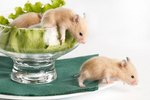
Under normal circumstances, female guinea pigs make capable mothers, able to raise litters without any significant effort from you. However, you may find yourself in a situation where you need to take care of newborn or extremely young pigs on your own. The evolutionary adatations of the guinea pig make this job easy, since guinea pigs mature quickly and become self-reliant after only a few days.
Early Days
During the first few days of life, nursing is important to establish a newborn guinea pig’s health. Without this benefit, young pigs face an uphill battle in early development. If the mother is not available, mash pellets or a recovery food such as Critical Care brand nutritional supplement powder together with canned pumpkin. If you have adult pigs, add a fecal pellet or two to the mix to provide some of the bacteria necessary for digestive health. Hand-feeding this mix every few hours for the first few days can help newborn guinea pigs survive the critical first week of life.
Solid Food
While guinea pigs will nurse for two weeks or more under normal circumstances, baby guinea pigs enter the world with fully formed teeth and are capable of eating solid food almost immediately. Choose alfalfa hay and pellets to provide extra calcium for growing bones, and provide plenty of both to satisfy growing pig appetites. Newborn pigs may not understand fruits and vegetables at first without an older guinea pig to observe, but they will eventually come around to the tasty treats. Hand-feeding baby pigs is a good way to establish a bond and familiarize them with human contact from a young age.
Baby-Proofing
When dealing with extremely young guinea pigs, give the cage an once-over to spot potentially dangerous conditions. Many cage designs focus on adult pigs rather than on youngsters, so water-bottle placement may not be ideal for smaller animals. In addition, cage bars that are too far apart may pose a threat to newborn guinea pigs, possibly allowing them to injure themselves. Before adding any new furnishings to the cage for young pigs, consider the potential danger for undersized animals.
Maturity
Since guinea pigs have relatively few defenses against predators in the wild, one adaptation they have developed is an extremely fast breeding and growth cycle. Newborn pigs enter the world with eyes open, able to eat solid food and run from danger. They also mature extremely quickly, with male pigs becoming sexually active around 3 weeks of age. For this reason, you need to separate young pigs by sex before week 4 to prevent possible pregnancy issues. Pairing a solitary boy or girl with an older cage mate of the same sex is a good way to initiate social development, or you can leave same-sex siblings together and take advantage of their familiarity with one another to promote harmony in the cage.
References
Resources
Photo Credits
-
BananaStock/BananaStock/Getty Images
Writer Bio
Milton Kazmeyer has worked in the insurance, financial and manufacturing fields and also served as a federal contractor. He began his writing career in 2007 and now works full-time as a writer and transcriptionist. His primary fields of expertise include computers, astronomy, alternative energy sources and the environment.




